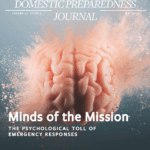Mass animal mortality events—whether triggered by infectious disease, natural disaster, or chemical toxicity events—create cascading challenges that extend beyond traditional carcass management strategies. Such incidents may raise environmental concerns, strain waste management systems, disrupt food supply chains, and pose risks to public health. Yet for many emergency management professionals, carcass management remains an unfamiliar and often siloed operational domain, typically confined to animal health or agricultural agencies.
This lack of familiarity can delay response coordination, blur jurisdictional responsibilities, and reduce the ability to manage cascading consequences. Carcass disposal is not merely a logistical concern—it is a complex, multidisciplinary function that touches public health, environmental protection, transportation, waste management, and crisis communication. The first 48 to 72 hours of a mass animal mortality event are critical. Decisions made during this window can shape community trust, regulatory outcomes, and the pace of recovery. This primer will not turn emergency managers into agricultural experts, nor does it need to. Instead, it provides the foundational awareness needed to incorporate carcass management into broader emergency operations—particularly in regions where animal agriculture is a central part of the economy and landscape.
By offering a streamlined overview of disposal methods, regulatory frameworks, real-world examples, and planning strategies, this article is a starting point for emergency professionals to engage with one of the more complex and often overlooked domains in the all-hazards preparedness spectrum.
Mass Mortality Events in Agriculture
Mass animal mortality events may happen at any time and be triggered by a variety of factors. Animal diseases (e.g., highly pathogenic avian influenza, swine fever outbreaks), natural hazards (e.g., fires, floods, winter storms), utility failures, and supply chain disruptions have all resulted in large-scale animal deaths across the United States. Carcass management operations typically are performed in conjunction with depopulation and decontamination, which are referred to as “3D” when combined with disposal efforts. While these events vary in cause and context, the operational challenges they produce are strikingly similar: excess biomass and limited disposal options, necessitating a swift and coordinated response to prevent public and environmental consequences from escalating.
The scale of these incidents can be staggering. A single poultry facility may house tens of thousands of birds, while commercial swine operations, dairies, and cattle feedlots can contain hundreds and sometimes thousands of large animals. When widespread death occurs—whether gradually through disease, or suddenly through natural disaster or emergency depopulation—the result is a logistical and public health emergency. In March 2025, severe flooding in Queensland, Australia, exemplified this challenge: initial estimates reported over 100,000 livestock deaths, with projections reaching half a million as floodwaters recede, mud dries, and access to affected areas improves.
What differentiates these events from other emergencies is the biological and environmental volatility of the material involved. Carcasses decompose quickly, generating leachate, odors, and gases that can contaminate air, water, and soil. They may also carry infectious agents, which complicate transport and disposal logistics and increase the risk of disease spread. In some cases, disposal delays have resulted in runoff contamination or secondary pest infestations, exacerbating community tensions and triggering regulatory investigations.
Despite their frequency and severity, mass mortality events in livestock and poultry operations often remain outside the operational radar of many local emergency management offices. This disconnect can leave emergency responders underprepared, particularly when events escalate rapidly and cross jurisdictional or functional boundaries. Without prior planning, assumptions about roles, resources, and disposal capacity can quickly break down.
Understanding the scope and stakes of these events is the first step toward integrating agricultural emergencies into the broader preparedness landscape. Recognizing mass animal mortality as a high-consequence incident allows emergency managers to anticipate cascading impacts and coordinate more effectively with agricultural, environmental, and public health partners.
Disposal Methods: Balancing Efficiency, Cost, and Impact
Once a mass animal mortality event is underway, carcass management rapidly emerges as a critical operational concern. The decision is not merely logistic. It carries significant implications for environmental protection, regulatory compliance, continuity of operations, and public confidence. Emergency managers are often required to make timely decisions in a complex and unfamiliar context, where no single disposal method provides a universally optimal solution. To aid in these determinations, authoritative guidance from the U.S. Department of Agriculture (USDA) and the American Veterinary Medical Association outlines acceptable disposal methods, balancing scientific, ethical, and regulatory considerations. These frameworks serve as essential reference points for aligning response efforts with both best practices and jurisdictional requirements.
A range of disposal options exists, each associated with distinct operational trade-offs.
- On-site burial: Quick and often locally accessible but requires suitable soil conditions, poses groundwater contamination risks, and may be restricted by environmental regulations.
- Composting: A biologically secure and environmentally suitable option that transforms carcasses into usable organic material. However, it requires adequate space, proper carbon materials, and trained personnel to manage the process correctly.
- Rendering: Converts carcasses into usable byproducts such as fats and proteins. While efficient, rendering capacity is limited, and many facilities will not accept diseased or contaminated animals.
- Landfilling: Offers a permitted and contained off-site disposal route, but access may be limited by disposal fees, public resistance, transport constraints, or facility refusal during disease outbreaks.
- Incineration: Effective at pathogen destruction and volume reduction but resource-intensive, slow, and subject to air-quality permitting and local environmental opposition.
The viability of each method depends on situational variables: the number and type of animals involved; environmental and biosecurity conditions; weather; site access; and availability of equipment, labor, and regulatory approvals. In practice, jurisdictions may need to pivot between methods as conditions evolve.
While agricultural and environmental authorities typically lead carcass disposal operations, emergency managers play a critical coordinating role. Supporting logistics, aligning interagency efforts, and communicating with the public all depend on a basic awareness of disposal options and their limitations. In high-consequence events, timely, well-informed disposal decisions are key to avoiding further disruption and protecting public health and the environment.
Navigating the Carcass Management Regulatory Landscape
Carcass management does not occur in a regulatory vacuum. Disposal operations must navigate a patchwork of federal, state, tribal, and local laws—each with its own permitting processes, jurisdictional boundaries, and enforcement mechanisms. Emergency managers entering this space often discover that even urgent, time-sensitive decisions must adhere to environmental protection laws, disease control protocols, and public health safeguards. Failure to do so can trigger enforcement actions, introduce delays, or lead to long-term environmental and reputational consequences that undermine both response efforts and public confidence.
Though carcass management is the responsibility of animal owners, key entities involved in carcass disposal include state departments of agriculture, environmental agencies, public health authorities, and, where applicable, tribal governments and local land-use boards. These efforts are coordinated with agencies such as USDA—particularly the Animal and Plant Health Inspection Service Veterinary Services—and the Environmental Protection Agency, which together provide scientific guidance and environmental oversight during animal disease events. Although these entities often pursue a shared goal, their mandates and priorities can differ. For example, an action permissible under emergency animal health authorities may still require environmental clearance, while local health departments may impose additional controls to prevent secondary nuisances such as odor, pests, or vermin.
The regulatory landscape is not merely a technical hurdle—it represents a coordination challenge. Emergency managers are not expected to master every statute or policy, but they must understand who holds decision-making authority, how approvals are granted, and when to engage critical partners. Carcass disposal operations are more likely to succeed when supported by pre-established relationships, clearly defined roles, and, where feasible, pre-approved emergency waivers or contingency protocols. Proactive engagement with regulatory agencies can minimize operational delays, streamline decision-making, and foster trust when it matters most.
Lessons From the Field: Case Studies in Carcass Management Operations
Empirical evidence from recent and historical events highlights the critical need to include carcass management within broader emergency planning frameworks. The 2015 Winter Storm Goliath in the Southern Plains resulted in the death of over 40,000 dairy and beef cattle, overwhelming local disposal capacity. With road closures, freezing conditions, and limited on-site options, carcass accumulation quickly became a secondary crisis. Similarly, the 2024 Smokehouse Creek Fire in the Texas Panhandle resulted in the death of an estimated 15,000 cattle, compounding the toll on ranching operations already strained by drought and market volatility, and contributing to an estimated $123 million in agricultural losses. In both instances, disposal efforts were hindered not by lack of intent, but by insufficient pre-incident coordination and the absence of scalable, adaptable operational plans.
The ongoing highly pathogenic avian influenza response has presented another layer of complexity. Since 2022, the virus has affected over a hundred million birds across commercial and backyard flocks in the United States. States have employed a range of carcass management strategies with varying degrees of success. Differences in planning, coordination, and stakeholder engagement have likely played a significant role in shaping the speed and effectiveness of state-level response efforts.
International and historical examples offer additional insight. The 2001 United Kingdom foot-and-mouth disease outbreak resulted in the depopulation of over six million animals and exposed the limits of centralized control over local carcass management logistics. Inadequate communication, public backlash against mass pyres and burial, and regulatory gridlock hampered response effectiveness and left lasting impacts on community trust. More recently, during the 2023 Kansas heat wave, thousands of feedlot cattle perished in just a few days. Without pre-identified and established contingency disposal strategies, such events may lead to increased regulatory scrutiny and attract negative media attention.
Across these contexts, one finding remains consistent: jurisdictions that integrated carcass disposal into emergency preparedness efforts—through cross-sector planning, regulatory pre-clearance, and coordinated workforce development and training—fared better. They responded faster, minimized environmental and reputational fallout, and communicated more clearly with the public. Carcass management, when neglected, becomes a compounding risk. When anticipated, it becomes a manageable component of resilient emergency operations within an agricultural context.
Planning Considerations
Proactive planning remains the most effective means of mitigating the operational, environmental, and reputational risks associated with mass animal mortality events—as demonstrated by New Mexico’s 2022 planning efforts, which integrated carcass disposal into broader emergency management frameworks. Although carcass disposal is often viewed as a technical or agricultural concern, it must be framed as a core emergency management capability—particularly in regions with concentrated livestock or poultry production. Integrating carcass disposal into emergency operations plans, functional annexes, and continuity frameworks ensures that decision-making does not start from scratch during a crisis.
Effective planning requires more than a checklist. It begins with identifying key partners—state veterinarians, agricultural extension offices, environmental regulators, industry stakeholders—and mapping available disposal assets under routine and emergency conditions. Pre-event actions might include establishing permitting workflows for burial or composting, conducting site assessments for temporary disposal, and drafting mutual aid agreements with rendering facilities or landfills. Incorporating carcass management scenarios into tabletop and functional exercises can also expose planning gaps and clarify interagency roles before those gaps become operational failures.
Carcass management may not be a daily concern for most emergency managers, but in the face of mass animal mortality, it becomes a defining test of operational readiness, interagency coordination, and public trust. These events expose the seams between sectors—agriculture, environment, public health, and emergency response—and demand a level of integration that cannot be improvised in real time. By bringing carcass disposal into the all-hazards fold, emergency managers fill a critical planning gap and reinforce the broader resilience of the communities, industries, and ecosystems they protect.
The views expressed in this article are solely those of the authors and do not represent the views or positions of their respective institutions.

Joshua Dise
Joshua Dise is an interdisciplinary national security and emergency management professional with experience in both operational and analytical roles. His work addresses complex and interconnected risks, including industrial hazards, transboundary diseases, cybersecurity, and systemic threats to critical infrastructure. He currently serves as a systems analyst at Sandia National Laboratories, where he provides decision support on ill-defined, multi-domain national security challenges using a broad range of technical skills and expertise. Prior to this, he served as a lead technical analyst and emergency planner at Sandia, where he was responsible for delivering a variety of hazard analyses and consequence assessment products. His research interests include environmental hazard response, biosecurity, agricultural and public health preparedness, natural resource management and security, and the convergence of digital and physical infrastructure risks. Joshua holds advanced degrees in emergency management and natural resources and is currently a Ph.D. student at Oklahoma State University, studying fire and emergency management administration. He is also an alumnus of the National Preparedness and Leadership Initiative at Harvard University.
- Joshua Disehttps://domprep.com/author/joshua-dise
- Joshua Disehttps://domprep.com/author/joshua-dise
- Joshua Disehttps://domprep.com/author/joshua-dise
- Joshua Disehttps://domprep.com/author/joshua-dise

Marshal Wilson
Marshal Wilson is the co-director of the Southwest Border Food Protection and Emergency Preparedness Center and provides leadership from the New Mexico Department of Agriculture. In addition, Marshal is the assistant division director for Agricultural Production Services and is the Emergency Support Function #11 coordinator for New Mexico. Marshal provides overall leadership and expertise to planning, training, and exercise program(s) focusing on agriculture and food systems.
- Marshal Wilsonhttps://domprep.com/author/marshal-wilson






